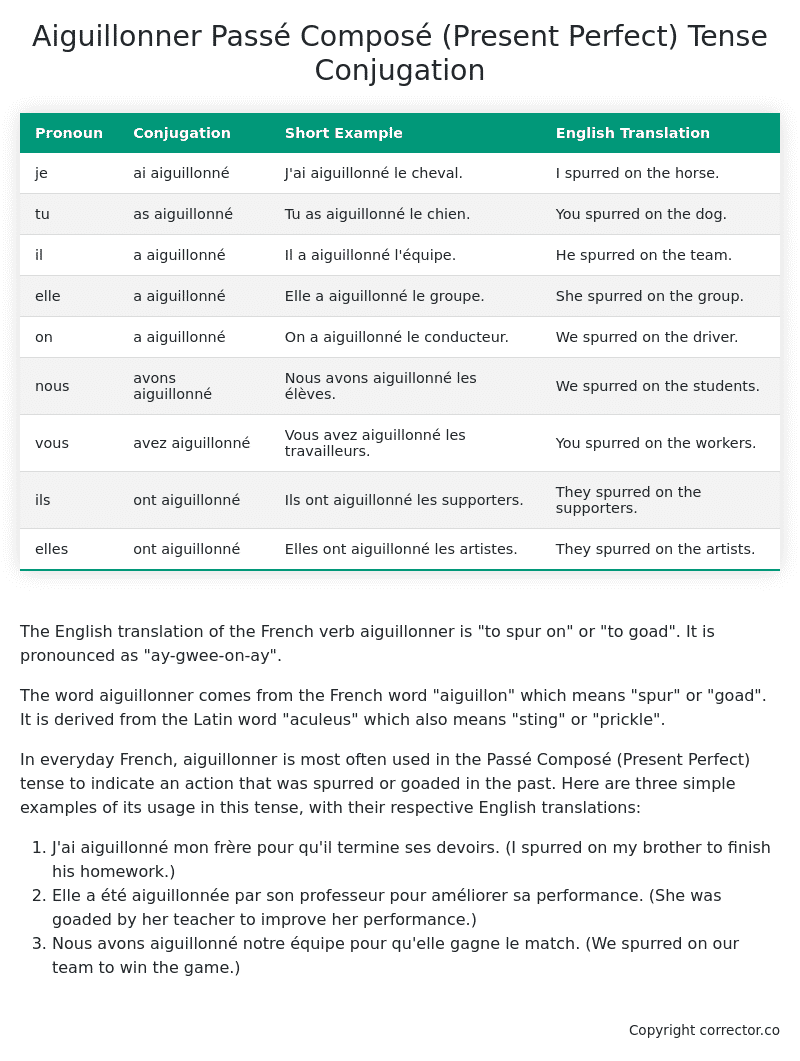Passé Composé (Present Perfect) Tense Conjugation of the French Verb aiguillonner
Introduction to the verb aiguillonner
The English translation of the French verb aiguillonner is “to spur on” or “to goad”. It is pronounced as “ay-gwee-on-ay”.
The word aiguillonner comes from the French word “aiguillon” which means “spur” or “goad”. It is derived from the Latin word “aculeus” which also means “sting” or “prickle”.
In everyday French, aiguillonner is most often used in the Passé Composé (Present Perfect) tense to indicate an action that was spurred or goaded in the past. Here are three simple examples of its usage in this tense, with their respective English translations:
- J’ai aiguillonné mon frère pour qu’il termine ses devoirs. (I spurred on my brother to finish his homework.)
- Elle a été aiguillonnée par son professeur pour améliorer sa performance. (She was goaded by her teacher to improve her performance.)
- Nous avons aiguillonné notre équipe pour qu’elle gagne le match. (We spurred on our team to win the game.)
Table of the Passé Composé (Present Perfect) Tense Conjugation of aiguillonner
| Pronoun | Conjugation | Short Example | English Translation |
|---|---|---|---|
| je | ai aiguillonné | J’ai aiguillonné le cheval. | I spurred on the horse. |
| tu | as aiguillonné | Tu as aiguillonné le chien. | You spurred on the dog. |
| il | a aiguillonné | Il a aiguillonné l’équipe. | He spurred on the team. |
| elle | a aiguillonné | Elle a aiguillonné le groupe. | She spurred on the group. |
| on | a aiguillonné | On a aiguillonné le conducteur. | We spurred on the driver. |
| nous | avons aiguillonné | Nous avons aiguillonné les élèves. | We spurred on the students. |
| vous | avez aiguillonné | Vous avez aiguillonné les travailleurs. | You spurred on the workers. |
| ils | ont aiguillonné | Ils ont aiguillonné les supporters. | They spurred on the supporters. |
| elles | ont aiguillonné | Elles ont aiguillonné les artistes. | They spurred on the artists. |
Other Conjugations for Aiguillonner.
Le Present (Present Tense) Conjugation of the French Verb aiguillonner
Imparfait (Imperfect) Tense Conjugation of the French Verb aiguillonner
Passé Simple (Simple Past) Tense Conjugation of the French Verb aiguillonner
Passé Composé (Present Perfect) Tense Conjugation of the French Verb aiguillonner (this article)
Futur Simple (Simple Future) Tense Conjugation of the French Verb aiguillonner
Futur Proche (Near Future) Tense Conjugation of the French Verb aiguillonner
Plus-que-parfait (Pluperfect) Tense Conjugation of the French Verb aiguillonner
Passé Antérieur (Past Anterior) Tense Conjugation of the French Verb aiguillonner
Futur Antérieur (Future Anterior) Tense Conjugation of the French Verb aiguillonner
Subjonctif Présent (Subjunctive Present) Tense Conjugation of the French Verb aiguillonner
Subjonctif Passé (Subjunctive Past) Tense Conjugation of the French Verb aiguillonner
Subjonctif Imparfait (Subjunctive Imperfect) Tense Conjugation of the French Verb aiguillonner
Conditionnel Présent (Conditional Present) Tense Conjugation of the French Verb aiguillonner
Conditionnel Passé (Conditional Past) Tense Conjugation of the French Verb aiguillonner
L’impératif Présent (Imperative Present) Tense Conjugation of the French Verb aiguillonner
L’infinitif Présent (Infinitive Present) Tense Conjugation of the French Verb aiguillonner
Struggling with French verbs or the language in general? Why not use our free French Grammar Checker – no registration required!
Get a FREE Download Study Sheet of this Conjugation 🔥
Simply right click the image below, click “save image” and get your free reference for the aiguillonner present perfect tense conjugation!

Aiguillonner – About the French Passé Composé (Present Perfect) Tense
Formation of the Passé Composé
Set the auxiliary verb with either
Conjugate the auxiliary verb
Add the past participle
Common everyday usage patterns
Narrating Past Events
Sequential Actions
Describing Completed Actions
Interactions with other tenses
Imperfect Tense
Conditional and Future Tenses
Summary
I hope you enjoyed this article on the verb aiguillonner. Still in a learning mood? Check out another TOTALLY random French verb conjugation!


